Soundpeats Breezy And TOZO Open Buds TWS Review – Sentence First, Verdict Afterwards
I purchased the Soundpeats Breezy and TOZO OpenBuds myself for this review.
Open-ear buds are rapidly getting better, but $150-300 is still too expensive for a non-audiophile, limited use device. I was intrigued to see Soundpeats (which has produced some good TWS in-ears) trot out a well-spec’d, nice-looking entrant for $39; when Amazon tacked on a 40% off coupon I couldn’t resist. I had lower expectations for TOZO, whose flagship Golden X1 TWS (review here) was a bust, but I read enough good things about the Open Buds to risk the $45 in gift cards.
The Soundpeats Breezy are nicely packaged, although the type on the accompanying user manual is so tiny as to be unreadable. Like, really tiny. They look generic/plasticy, but have adjustable earpieces which enable one to swivel the speakers for better fit and sound quality—it’s a clever feature which every manufacturer should copy.
Very lightweight; memory-wire earhooks seem unstable but actually held the buds in place much better than expected. Charging case is small and sleek even if returning the buds to the case requires some fiddling with the earhooks. 10 hr. battery is most welcome; touch controls (programmable in the app) work pretty well.
The accompanying Peats Audio app was a bit of pain to download and register, but is actually well-conceived, with a very sophisticated custom EQ, multipoint and the like. Call quality is typical for the breed—acceptable indoors and challenging in windy outdoor conditions.
In contrast to the lean, spiky timbre of most of its peers, the Breezy has a warm, rich-textured tone with a mild L-shaped signature which emphasizes the midbass reason. There’s not much discernible subbass; mids are full-sounding, but somewhat congested.
Treble is smooth and sibilant-free, with very limited extension—there’s audible roll-off around that 20kHz region, which causes pianos and electric guitars to sound soft and cymbals to miss some shimmer.
Soundstage is narrow and low on these—the performers are bunched into the center stage—and instrument placement is imprecise. Compared to the airy, punchy presentation of the $59 Baseus Eli Sport (review here), the Breezy sound closed-in, lacking in detail and kinda dark.
The Breezy are certainly cheap and comfortable, their UI and tech are laudable and they’re serviceable for podcasts or audiobooks. Ultimately, though, they are a good design let down by sub-par sonics and you’d be better served to spend a little more for better.
Specifications Soundpeats Breezy
| Type: Open ear, open buds Driver: 14.2 mm, dynamic Frequency Response: 20 – 20,000 Hz Audio Codecs: AAC/SBC Bluetooth Version: 5.4 Bluetooth Range: 10 m Battery Capacities: 54 mAh (earphone), 500 mAh (charging case) Charging Time: 2h (earbuds), 3 h (charing case) Charging Port: USB-C Music Playtime: 10 h (single charge) + an additional 30 h (charging case) = totals 40 h In the Box: SOUNDPEATS Breezy Open-ear Earbuds, Type-C Charging Cable, Charging Case, User Manual, App Guide Cartoon stickersTested at: $39.99 Product Page/Purchase Link: soundpeats.com |
The TOZO Open Buds are hardly eye-catching—the oversized earpieces look dowdy and jerry-rigged, and the buds are heavier than the norm; unlike the Breezy or the Baseus Sport Eli you won’t forget you’re wearing ‘em. Fit, however, is very stable and comfort better than expected. Most critically, the rotating shells enable optimal placement of the drivers.
Connectivity is seamless and touch controls are reliable and logical. The accompanying app, which provides merely for customizing the touch controls and for some preset EQs, is inessential, although I found the “Classical” setting a marginal improvement over the default tuning.
I was frankly surprised by how good these things sound. First and foremost, they play loud and in-yo-face; even at 50% they present a rich, visceral texture with (at least by open-ear standards) considerable subbass thump. Low end is a tad soggy—decay is slow and there’s a syrupy quality to it, albeit in a pleasant way.
Mids are forward and very clear—vocalists are pushed front stage—while high end is reasonably well extended and free from glare—there’s a bit of smoothing over of the highest frequencies, which blurs drumheads and reeds. Soundstage is very 3D, with considerable stereo spread and accurate instrument placement—on certain denser materials the OpenBuds show the airiness and width of open-back headphones. Coherence isn’t seamless (the big low end can intrude into the mids), but they avoid sounding analytic or clinical; they’re sorta analoguish.
I’d still rate the crisper, more-detailed Baseus a notch higher, although the TOZO actually sound bassier and bigger. Stepping up to the $150 class like the Oladance OWS or the interesting new Nothing Ear Open will yield you a silkier tone and more refinement and resolution, esp. at the high-end, but it’s not a big gap—in less-than-optimal listening environments the fuller, louder OpenBuds might actually be the better pick. Damn good for the money in any case.
Specifications TOZO Open Buds
| Type: Open ear, open buds Driver: 14.2 mm, dynamic Frequency Response: 20 – 20,000 Hz Audio Codecs: AAC/SBC Noise Cancellation: DSP call noise cancellation Bluetooth Version: 5.3 Bluetooth Range: 10 m Battery Capacities: 70 mAh (earphone), 600 man (charging case) Charging Time: 1.5 h (earphones), 1.5 h (charging case) Charging Port: USB-C Music Playtime: 12 h (single charge) + an additional 30 h (charging case) = totals 42 h In the Box: TOZO Open Buds Wireless Earbuds, Charging Case, Charging Cable, Quick Guide & User Manual Tested at: $99 Product Page/Purchase Link: Tozostore |







